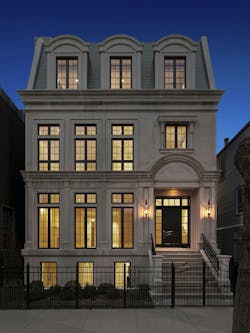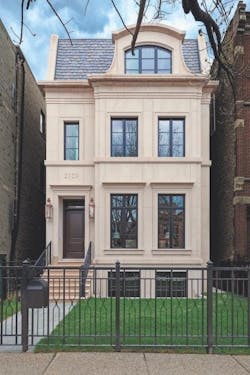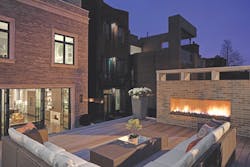Backstory: Sense + Sensibility
About 170 homes ago, architect and builder Ken Brinkman designed and built his first spec home, a small frame house with vinyl siding on a narrow lot. “We tried to create a configuration that was efficient and gave a future owner a lot of livable space,” says the owner of Environs Development, in Chicago. And, looking back, he wouldn’t change a thing, he says, since “the house was perfect for the time and the location.” But that first house also taught Brinkman a valuable lesson that continues to inform how he does business: “I designed that home for a couple with kids—people like me and my wife—and the people who bought it were a gay couple with no children. It taught me about being flexible. The client’s wants and needs are more important than mine.”
Loss and Profit
Few 8-year-old boys would enjoy being toted around to open houses, but Brinkman didn’t mind. “My mom loved to look, and I’d grab a sales brochure, sit in the car, and redesign the house,” Brinkman recalls. To top it off, their home was in a subdivision that was in the midst of construction. “That was our playground,” he says.
There were many hurdles to leap between being a boy from a lower-middle-class background to owning and heading up a firm that employs a team of 25. “I was good at art, but I also liked math,” Brinkman says, “and architecture combines the two.” So he studied architecture at the University of Illinois at Urbana-Champaign. But Brinkman knew that in order to be successful and profitable in whatever field he chose, he’d need an edge, so he received an MBA from the University of Chicago and got a job with a commercial real estate firm. Then, in 1990, he recalls, “the field practically collapsed. Residential trusts took over the S&Ls and restructured the industry. I was invited to no longer work for the firm I was with.”
"We try to look like we were the nicest home on the block in 1890," says Environs Development owner Ken Brinkman, "but the interiors are more modern."
At the time of the layoff, Brinkman was married and had one child, with another on the way. He was terrified, he says, but told his wife he wanted to start a business. “The last few months before I sold that first house,” he says, “we were living on a Visa card to buy groceries. We didn’t want to lose our own home; our fallback was living next to our in-laws in a second home they owned next door to their own house in rural Kentucky. I don’t think we would have been happy there.” But Brinkman’s first spec house sold, and the commercial real estate world’s loss has been the architecture and custom home world’s gain.
Thoughtful Infill
Brinkman got the name for Environs from the title of a book of maps he used while a student in Paris studying architecture. And, after 26 years in business, the firm’s client base is no longer buying small, vinyl-sided spec houses for $330,000. With the company serving as designer, contractor, and developer, Brinkman acquires properties, mostly in the Chicagoland area, and designs a home or multiple homes for the site. Often, a sale is made before construction is complete, so clients are able to customize their home. “We can make pretty substantial changes to the character and style of a home, even if we have a full set of drawings,” Brinkman says.
Although he enjoys the luxurious David Adler houses of the 1920s and ’30s and Frank Lloyd Wright’s “flowing interior spaces that aren’t defined by walls,” Brinkman says he’s inspired by “everything that’s come before; I look at the work of all architects.” Since many of his homes are infill projects in Chicago’s older neighborhoods, they do tend to have “older characteristics,” he says. “We try to look like we were the nicest home on the block in 1890, but the interiors are more modern.” Spec homes now range in price from $3.5 million to $3.8 million.
Brinkman credits his success to a design-first philosophy and a collaborative approach. “There’s often a competitiveness between architects and designers. Here, we’re all on the same team and work together,” he says. But on the business side, he points out, getting an MBA changed the way he thought and has been a big advantage, helping him develop a solid financial sense and understand profit margins. “At the end of the day,” he adds, “isn’t that why we’re in business? To make money?”
To that end, Team Brinkman maintains several strong partnerships, one of which is with a real estate broker who’s a former banker. “She has worked with me for 26 years,” Brinkman says. “She’s sold every one of my houses for me, helps me find land, and is very much an adviser. Most developers think of Realtors as a cost they don’t want to incur, but that’s not my perspective.”
It was the broker who introduced Brinkman to a banker for his first construction loan and, Brinkman says, “we’ve kind of grown up together. I’m an important client for him and he’s an important resource for me.” Brinkman’s attorney is also someone he has known for 30 years. “It’s all about relationships,” Brinkman says. “That’s what my Realtor has taught me.”
Stacey Freed writes about design from her home in Pittsford, N.Y.


